|
|
||||||
|
HOME |
AZAWAKH
|
OUR DOGS
|
GALLERY
|
PUPPIES
|
LINKS
|
CONTACT
|
|
2. Diagnosing the genetic fault of Tarat
Tarat’s legs were really getting strange – one day they would look a bit better, the other much worse. One week after we bought Tarat we went to the vet’s to vaccinate him. The vet in Prague looked at his front legs. He agreed that puppies in this age can look funny and all twisted, but he thought Tarat’s legs were a bit too worrying to just sit and wait what happens. He suggested we should x-ray him in order to see what was going on with his long bones. Dr. Hnizdo had a suspicion that Tarat could have a Radius Curvus syndrome. I didn’t understand what he was talking about. I didn’t even want to remember the name of this syndrome. He pointed out that Tarat was standing on the extreme inner sides of his paws just like if he was trying to protect his elbows from too much pressure – typical for Radius Curvus. Even though dr Hnizdo ( http://www.animalclinic.cz/eng/team.html ) is probably the best vet I ever met in my life I was very skeptic about his way of thinking. I was sure Tarat was just having some growing problems. Anyway, the vaccination is normally quite a shock for a body of a little puppy, therefore we agreed we would wait with the x-rays at least another week, as it had to be done in sedation. In the meantime I contacted a German friend of mine, Nicole Holland, who is a trained animal physiotherapist and has a great knowledge of all sorts of growing problems and boning problems. She looked at the pictures of Tarat and she thought of Carpus Valgus. I was again skeptic, didn’t know what it all meant but I started to think maybe there was really something going on with this little folk. Nicole suggested I should change Tarat’s food. Up till now he was fed with the same food he got from the breeder: Nutro Puppy’s Choice for medium breeds. According to Carpus Valgus treatment, dogs should not be fed with high protein, commercial food. Nicole advised us to use a modified BARF diet, low calcium and low vit D levels – just the minimal ratios – no extra supplements, no puppy food. I was disappointed, as I just ordered a whole set of supplements and minerals for Tarat in Germany. The order was delivered but I was not supposed to give any of it to him – except for the Gelenk Flex. What a pity I thought. Carpus Valgus did not mean a lot to me at this time, but I started to panic a bit. I knew we had to do all we could to get the right diagnosis.
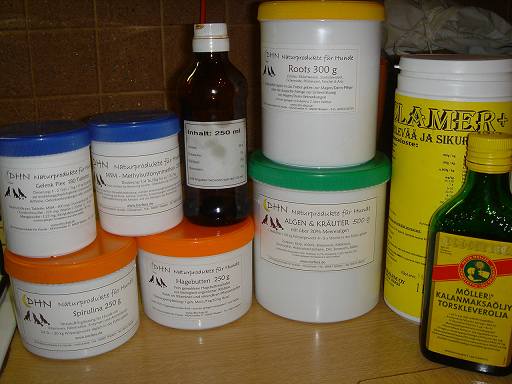
One week after the vaccination we were back for the x-rays but there was some kind of an emergency operation at the clinic, so we decided to come another day. As we were also planning to go to Poland the same week, I finally decided we would take Tarat with us and show him to dr Mlynarski there. He is a vet that I have known for years. He treated our late whippet at the end of his life (he lived 15 years!!!) and he proved to be excellent with sight hounds. In 2005 he was also the only vet among 7 different ones we visited with our sloughi boy (I co-own a sloughi male with a friend) who gave the right diagnosis of HOD. He also helped us to heal the sloughi and today he is a mature dog with almost no signs of HOD. Dr. Mlynarski looked at Tarat and he was surprised I bought this puppy as a “100% healthy and quality” dog. He pointed out several problems: - wrong legs - bad hair (we could see the skin through it) - all glands enlarged - general weak condition of a puppy
I explained to dr Mlynarski that Tarat had an allergy in the age of 4-6 weeks, had bold spots and I thought that maybe this was a reason for his weaker health condition. Dr. Mlynarski explained me that dogs’ immune system is not able to develop any allergic reaction till the age of about 6 months. An allergy is simply not possible with small puppies. Any kind of skin/hair problems have to be results of infections, demodex or fungus. The glands stay enlarged even up to 3 months after any kind of health problems/infections. The general conclusion was: Tarat had some very “bad past” at the kennel. My knees were getting really soft. I couldn’t believe it. Dr. Mlynarski suggested that sedation was too much for Tarat in his overall state. He took only one x-ray picture of the right front leg.
Dr. Młynarski was very careful about giving us a diagnosis at this point. The puppy was just over 3 months old. But he pointed out to us that the Ulna bone seemed to be shorter then Radius. He pointed there was a remaining cartilage structure at the end of Ulna which seemed to be stopping this bone from growing. This caused Radius to bow slightly as it was growing faster and was longer then Ulna. He checked Tarat’s blood for the Ca/P ratio. At this time it was 2,5Ca/0,5P. So, too low in phosphor. He hoped that Tarat still had a chance to grow out of his problems. He regretted we didn’t know if the breeder did anything to help the puppy’s leg to get better before we got him, nor did we know when exactly they started to look that way – he arrived to our home with wrong legs already. It must have started much earlier. He told us to feed the puppy with fish every day, to give him VMP tablets – one per day, avoid exercising, separate him from our other dog and observe. If we it was just a growing disturbance we should see within 2-3 weeks that Tarat’s legs were getting better. If not – we would have to think about genetic problem and most likely Radius Curvus syndrome. But he gave us hope. And I stuck to it. I observed Tarat every day. I was really angry at the breeders. How could they not notice Tarat’s wrong legs? Or how could they not tell us about it? We saw it the first day we got him… I wrote them an e-mail about the overall findings of Dr. Mlynarski. It started to be a bit uncomfortable for the breeder I guess. We got a reply in which we read, that indeed, the puppies did not have an allergy but some kind of an infection which was treated with a week of antibiotics. They also ensured us they didn’t want to sell us a problematic puppy but in their view Tarat was showing signs of Rachitic which they never had in 30 years of their breeding practice. Etc, etc. I was furious. This was a very delicate insinuation that we made this puppy suffer from Rickets. They alarmed us we should give Tarat injections of vit D3!!! I didn’t know if the breeders played silly or if they wanted to treat us as if we were silly. I guess even a child knows nowadays, that Rickets does not exist really in Europe anymore. The last diagnosis of Rickets were given before the II World War. A dog who is kept at home and eats normal food – whether commercial or BARF - is just not able to get Rickets!! Anyway, the above x-ray picture shows that the bones are properly mineralized. As Mr. Hochgesand is a medical doctor – one could expect he knows how to read the radiographs. There are no signs of Rickets on this x-ray. Not to mention that Rickets shows at all body not only at front legs, but most of all ribs etc. I decided I would not argue with the breeders. I felt we were getting to a very delicate matter here and thin ice – a possible genetic fault. And many breeders will use all means (even “low level kicks”) to avoid this truth to come out. It was also in my interest to diagnose Tarat in the best possible way. After all I bought him as a stud dog!
Here you can see the dramatic conditions in which Tarat lives at our home – conditions in which he “developed” his “rickets”  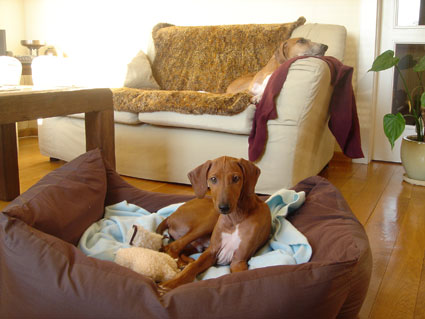  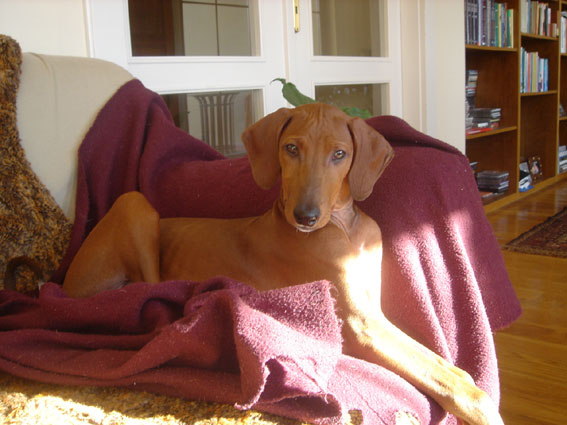  Is this how you imagine dramatically bad conditions? Is this what a mistreated dog looks like?
I observed Tarat’s development impatiently. The day after we came back from Poland Tarat’s legs looked like this: 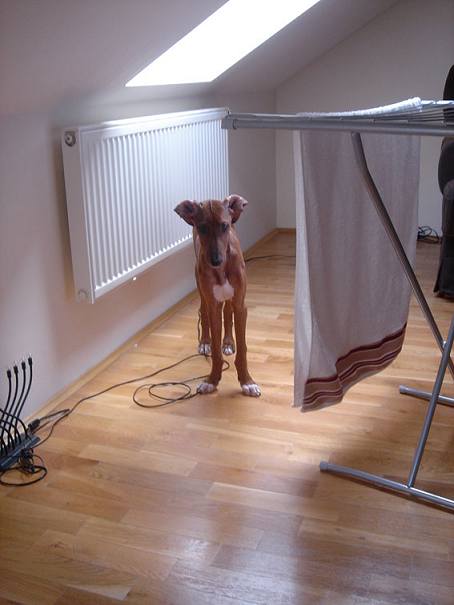 I started to do all I was advised to do. Tarat was getting fish ever day, we bought whole fish, we cooked it together with the bones and then mixed it into a paste in a machine. I cooked vegetables for him and mixed it into a paste as well. We imported horse meat from Poland – hearts, as they have a slightly higher phosphor content then calcium, as well as horse meat is supposed to be the cleanest on the market – no hormones, no other additives. Tarat was not getting any grain, as dogs with any bone problems should avoid it. He was separated from Tatarit most of the day. They would only be allowed to play for 15 minutes per day. He was not allowed to walk the stairs anymore, and we brought a special woolen rug from Poland (which ironically I took away when Tatrit was a puppy as I didn’t want her to destroy it :-) ). Tarat was not supposed to walk on slippery surfaces… We did all we could in order to guarantee him the best life conditions.
After a week Tarat looked somehow better:
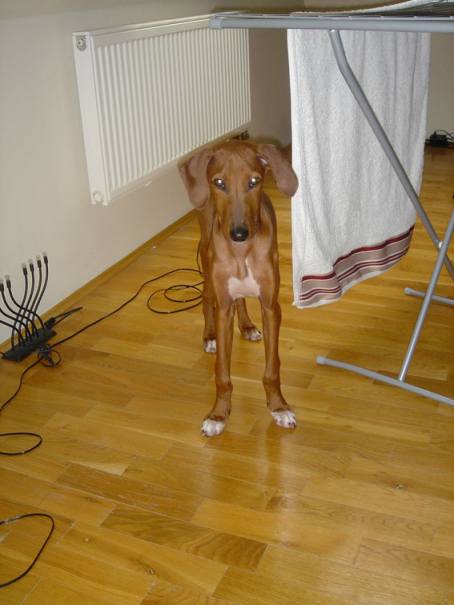 His paws were not so stressed. It turned out later that this was only due to the change of diet – he simply lost some weight and his paws could straighten up a bit. But the long bones were still curved – which is maybe not so evident on the normal pictures.
We scheduled the next control x-ray pictures in Prague with Dr. Hnizdo. We showed him the one we took in Poland. It was a bit too law quality but Dr. Hnizdo seemed worried and he was almost sure Tarat had Radius Curvus caused by a premature Ulna closure (http://www.shilohgtf.com/Premature%20Closure%20Ulna.htm ). In this case treating the dog like if he had Rickets would have caused even more damage. But Dr. Hnizdo had a bit of a laugh about the Rickets suspicions anyway.
We waited over a week more. In this time I studied the Internet and I knew that if we get the final diagnosis confirming the previous suspicions of Radius Curvus we would most likely have to operate Tarat. I contacted the breeder. I wrote an e-mail and I decided that if Tarat needs an operation we would need to give him back. I was in the 4th month of pregnancy, my mother was in the middle of chemotherapy as she is sick of cancer, and I just didn’t see how we could go through a very difficult process of rehabilitation with Tarat – it takes over 8 weeks. Not to mention I didn’t see a reason for which I should go through all this hassle when I bought a dog from “ the best kennel in the World” – in my understanding any genetic faults are to be dealt with by the breeders. I wrote in my e-mail on March the 15th, that if we got the worst diagnosis we would like to bring Tarat back on Saturday March the 25th. I didn’t get any answer for this e-mail. I tried to suggest that Mr. and Mrs. Hochgesand would take Tarat back only for the operation and for the rehabilitation and then return him to us – but this offer was ignored just as well. The last news I had from the breeder was from the 12th of March, in which they agreed they would take Tarat back home and refund us a purchase price if we didn’t want him anymore…. A week passed. On the 22nd of March Tarat was sedated and x-rayed. These are the pictures from this session – 5 weeks after we bought him:
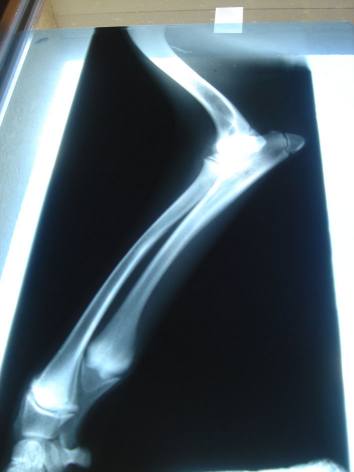  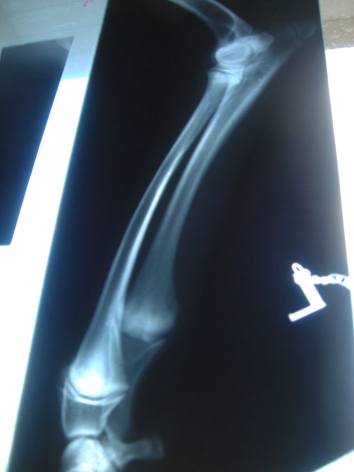
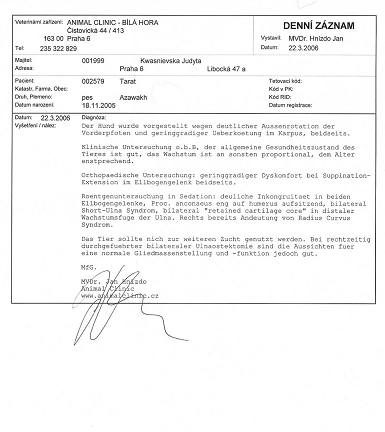
NI wrote to the breeders, I informed we had to bring Tarat back the
following Saturday. As soon as possible as he had to be operated within
next 14 days. I didn't get any answer. I called the next day in the
morning - Thursday the 23rd. Anne Hochgesand told me that they would take
Tarat back but not earlier then in two weeks, as they are not ready to
have him at this moment. I was shocked! I wrote them a week earlier about
this possibility. As I got no answer I was sure they just accepted it.
|
||||||

